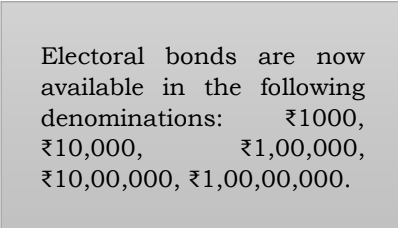Why in NEWS
The Supreme Court on Tuesday fixed October 31 for hearing a slew of petitions challenging the electoral bonds scheme.
Electoral Bond
Electoral Bond is a mode of funding to political parties in India. The scheme of Electoral Bond was introduced in The Finance Bill, 2017 during Union Budget 2017-18 when the maximum limit of cash donation to political parties was capped at ₹2,000 by Union Minister for Finance and Corporate Affairs.
The scheme removes all pre-existing limits on political donations. This effectively allows well-resourced corporations to fund elections, which can pave the way for crony capitalism.
The Finance Act, 2016 has amended the Foreign Contribution Regulation Act, 2010, to allow foreign companies with subsidiaries in India to fund political parties in India, effectively exposing Indian politics and democracy to international lobbyists.

The Finance Act of 2017 has introduced the use of electoral bonds which are exempt from disclosure under the Representation of the People Act, 1951, opening doors to unchecked, unknown funding to political parties.

Aim

- Enhance transparency in political funding
- Reduce the influence of illicit money in politics
- Promote a more accountable and transparent electoral process
Issuing authority
- State Bank of India (SBI) is the authorized issuer.
- Electoral Bonds are issued through designated SBI branches.
Recent Problem
Primarily on two issues concerning the electoral bonds scheme, that is, the legalisation of anonymous donations to political parties and the violation of citizens right to information about the funding of political parties, promoting corruption. The two issues concern violation of Articles 14, 19 and 21 of the Constitution.
- They may compromise the right to know, which is part of the right to freedom of expression under Article 19 of the Constitution.
- The government can always access the donor details by demanding the data from the State Bank of India (SBI).
- The concentration of political funding in a few cities raises concerns about transparency and fairness in political financing.
- The scheme is an obscure funding system which is unchecked by any authority.
Sedition in Indian context
Sedition refers to crime against state dealt with in the section 124A of the Indian Penal Code.
Historical Background
- Sedition laws were initially enacted in 17th CE England to curb negative opinion against the government and monarchy.
- In India, the law was originally drafted in 1837 by Thomas Macaulay but omitted upon enactment of the IPC.
- Later, Section 124A was inserted to IPC in 1870 by an amendment introduced by Sir James Stephen.
- The law had been used by the British authorities to arrest Lokmanya Tilak and Mahatma Gandhi in pre-independent India.
Section 124A of IPC
Whoever, by words, either spoken or written, or by signs, or by visible representation, or otherwise, brings or attempts to bring into hatred or contempt, or excites or attempts to excite disaffection towards, the Government established by law in, shall be punished with imprisonment for life, to which fine may be added, or with imprisonment which may extend to three years, to which fine may be added, or with fine.
Sedition constitutes
- Spoken or written words, signs, visual depiction
- Against any content that has potential to incite violence or disruption
- Against any content that incites hatred, contempt, or disaffection for government.
- Against threats to stability of the state or authority of the government.
- Does not include criticism against legislative or administrative decisions made by the government.
Offence so committed are non-bailable and penalties include
- Prison for up to three years
- A life sentence in prison
- A life sentence in prison and a fine
- Up to three years in jail and a fine
- Only fine
Judge makes the choice based on severity of punishment to be met out to convicted party.
Relevant cases
Romesh Thappar v. the State of Madras and Brij Bhushan and Others v. the State of Delhi (1950)
SC ruled that restrictions on the grounds of disruption of peace for freedom of speech was unlawful. Thus, Article 19 (2) of the Constitution was revised to read “in the interest of public order” instead of “undermining the security of the State.”
Kedarnath Singh v. State of Bihar (1962)
Sedition will only be considered to be an offence if it causes or is likely to cause “public disorder” or “violence.”
Balwant Singh vs State of Punjab (1962)
Mere sloganeering cannot result in imprisonment under Section 124A unless there is public disruption.
Significance
- Prevents anti-national, separatist, and terrorist elements from causing disruption to public order
- Ensures stability for elected government and protects them from violent or illegal overthrowing.
- Imposes reasonable restriction on Article 19(2) of the constitution.
Controversy
- Misapplied to suppress political opposition
- Prevents people from exercising their right to free speech and expression
Context
Delhi Lieutenant-Governor V.K. Saxena granted prosecution sanction against author Arundhati Roy and former Kashmir University Professor Sheikh Showkat Hussain in a 13-year-old case where the two were alleged to have propagated the “separation of Kashmir from India” during a conference in the national capital.
Other NEWS
| Padma Bridge Rail Link |
|
| Protocol for Management of Malnutrition in Children |
|
| India’s spacetech industry has ‘downstream’ potential |
|
 Chinmaya IAS Academy – Current Affairs Chinmaya IAS Academy – Current Affairs
Chinmaya IAS Academy – Current Affairs Chinmaya IAS Academy – Current Affairs


